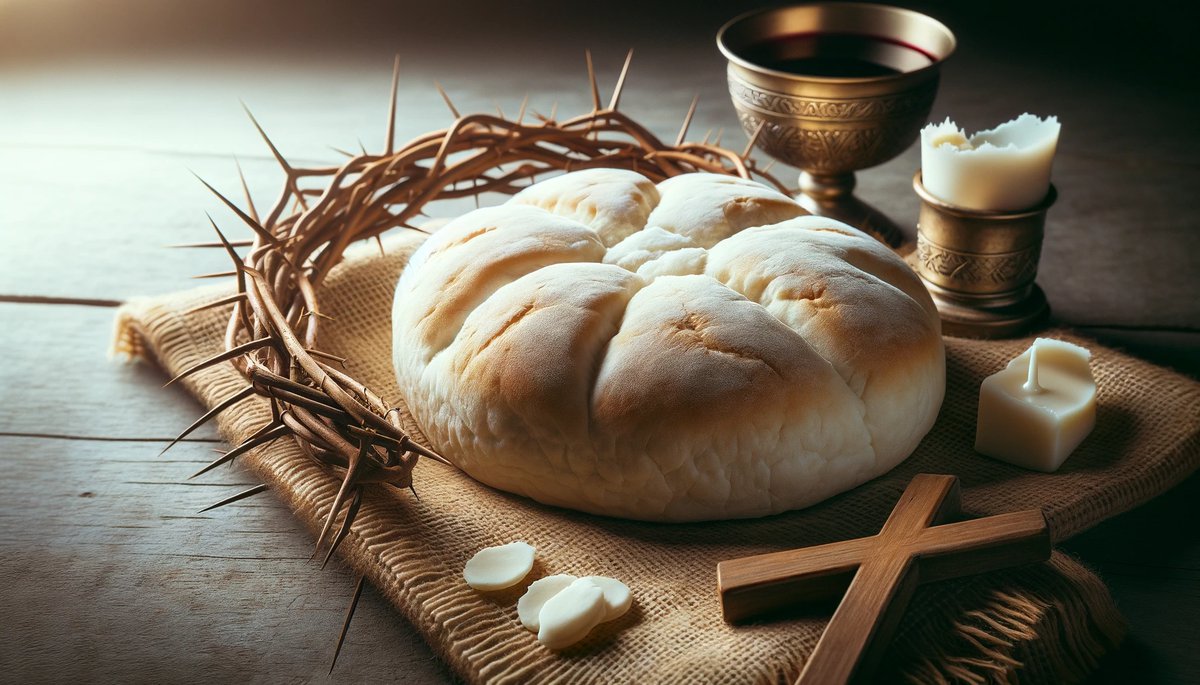Home>Theology and Spirituality>What Is Communion Bread Called


Theology and Spirituality
What Is Communion Bread Called
Published: February 19, 2024
Ericka Andersen, an editor at Christian.net, expertly merges digital strategy with content creation, focusing on faith and societal issues. Her communication skills enhance the platform's engaging narratives, fostering meaningful dialogue on belief's impact on society.
Discover the significance of Communion bread and its various names in theology and spirituality. Learn about the spiritual symbolism and traditions.
(Many of the links in this article redirect to a specific reviewed product. Your purchase of these products through affiliate links helps to generate commission for Christian.net, at no extra cost. Learn more)
Table of Contents
Introduction
Communion bread, also known as the Eucharist or the Lord's Supper, holds a significant place in Christian religious practices. It is a fundamental element of the communion service, symbolizing the body of Christ and serving as a means of spiritual nourishment for believers. The history, names, significance, and preparation of communion bread are all integral aspects that contribute to its profound importance within Christianity.
The tradition of communion bread traces back to the Last Supper, a pivotal event in Christian theology. During this sacred meal, Jesus shared bread with his disciples, instructing them to partake in remembrance of him. This act of sharing bread and wine has been perpetuated through the ages, forming the basis of the communion ritual observed in various Christian denominations.
The names used to refer to communion bread vary across different Christian traditions, reflecting the diverse linguistic and cultural backgrounds of believers. Understanding these names provides insight into the rich tapestry of Christian worship practices and the universal significance attached to this sacred element.
The significance of communion bread in Christianity extends beyond its physical form. It embodies the spiritual connection between believers and the teachings of Jesus Christ. The act of consuming the bread is symbolic of partaking in the body of Christ, signifying unity, redemption, and the promise of eternal life.
The process of making communion bread involves careful preparation and adherence to specific religious guidelines. The ingredients and methods employed in its creation are steeped in tradition and hold deep spiritual meaning for those involved in its production.
In the communion service, the distribution and consumption of the bread hold profound spiritual significance. It serves as a tangible expression of faith and a communal act of remembrance, fostering a sense of unity and spiritual nourishment among worshippers.
As we delve into the history, names, significance, preparation, and role of communion bread in the communion service, we gain a deeper understanding of its centrality in Christian worship and its enduring impact on the spiritual lives of believers.
Read more: What Bread Is Used For Communion
The History of Communion Bread
The history of communion bread is deeply rooted in the origins of Christianity, specifically stemming from the accounts of the Last Supper as documented in the New Testament of the Bible. According to the Gospels of Matthew, Mark, and Luke, during the Last Supper, Jesus Christ shared bread with his disciples, instructing them to partake of it as a representation of his body. This symbolic act of sharing bread and wine with his followers holds profound significance in Christian theology, as it signifies the establishment of the Eucharist, a central sacrament in Christian worship.
The act of breaking bread and sharing it with his disciples was a pivotal moment in the life of Jesus, as it served as a symbolic precursor to his impending sacrifice on the cross. The significance of this event was further emphasized when Jesus instructed his disciples to continue this practice in remembrance of him. This directive laid the foundation for the ritual of communion, where believers partake in the consumption of bread and wine as a means of commemorating the sacrifice of Jesus and reaffirming their faith.
Throughout the early history of Christianity, the practice of sharing bread and wine as part of the communion service became a central element of Christian worship. The act of consuming the bread was seen as a unifying symbol, representing the spiritual nourishment and unity of believers through their shared faith in Christ. As Christianity spread and evolved, various traditions and interpretations of the communion ritual emerged, each reflecting the cultural and theological nuances of different Christian communities.
Over the centuries, the history of communion bread has been intertwined with theological debates, religious reforms, and diverse cultural influences. Different Christian denominations have developed unique liturgical practices surrounding the preparation and distribution of communion bread, each with its own theological significance and symbolic interpretations. Despite these variations, the foundational significance of communion bread as a symbol of Christ's body and the spiritual nourishment it provides remains a unifying factor across Christian traditions.
The history of communion bread serves as a testament to the enduring legacy of the Last Supper and its profound impact on the development of Christian worship practices. It stands as a tangible link to the origins of the Christian faith, embodying the timeless significance of Jesus' teachings and the enduring spiritual bond shared by believers through the act of communion.
Different Names for Communion Bread
The communion bread, a central element of Christian worship, is known by various names across different denominations and cultural contexts. These names reflect the diverse linguistic and historical influences that have shaped Christian religious practices. Understanding the different names for communion bread provides insight into the rich tapestry of Christian worship traditions and the universal significance attached to this sacred element.
-
Eucharist: In many Christian traditions, the communion bread is referred to as the Eucharist, a term derived from the Greek word "eucharistia," meaning thanksgiving. This name underscores the act of gratitude and remembrance associated with the consumption of the bread, emphasizing its role as a symbol of Christ's sacrifice and the redemptive grace extended to believers.
-
The Lord's Supper: Another common name for communion bread is the Lord's Supper, drawing from the biblical accounts of the Last Supper where Jesus instituted the practice of sharing bread and wine with his disciples. This name highlights the communal aspect of the ritual, signifying the fellowship and spiritual unity experienced by believers as they partake in the symbolic meal.
-
Holy Communion: The term "Holy Communion" is widely used to describe the act of partaking in the bread and wine during the communion service. It emphasizes the sacred nature of the ritual and underscores the spiritual communion between believers and Christ, as well as the bond shared among members of the Christian community.
-
The Blessed Sacrament: Within certain Christian traditions, the communion bread is referred to as the Blessed Sacrament, emphasizing its sanctified nature and the divine presence believed to be inherent in the elements. This name underscores the reverence and adoration accorded to the bread as a tangible manifestation of Christ's presence among the faithful.
-
The Body of Christ: In some denominations, the communion bread is simply referred to as the Body of Christ, directly invoking the scriptural imagery of Jesus' body being broken for the salvation of humanity. This name serves as a poignant reminder of the sacrificial nature of Christ's offering and the spiritual nourishment received through the act of consuming the bread.
-
Host: The term "host" is often used to describe the communion bread, particularly in Catholic liturgical contexts. Derived from the Latin word "hostia," meaning sacrificial victim, this name underscores the sacrificial aspect of Christ's offering and the redemptive significance attributed to the bread within the context of the Eucharistic celebration.
These diverse names for communion bread reflect the multifaceted theological, historical, and cultural dimensions of Christian worship. They encapsulate the profound spiritual significance attached to this sacred element and serve as a testament to the enduring legacy of the communion ritual across diverse Christian traditions.
The Significance of Communion Bread in Christianity
The communion bread holds profound significance within the framework of Christian theology and worship practices. Its symbolic importance transcends its physical form, embodying the central tenets of the Christian faith and serving as a tangible expression of spiritual communion and redemption.
At the core of its significance lies the scriptural foundation established during the Last Supper, where Jesus Christ shared bread with his disciples, instructing them to partake in remembrance of him. This act of sharing bread symbolized the impending sacrifice of Christ's body, laying the groundwork for the ritual of communion observed by believers across denominational lines.
The consumption of communion bread represents the spiritual nourishment derived from the teachings and redemptive grace of Jesus Christ. It serves as a poignant reminder of the sacrificial nature of Christ's offering, emphasizing the unity of believers through their shared participation in the symbolic meal. The act of consuming the bread is not merely a ritualistic practice but a profound expression of faith, signifying the believers' acceptance of Christ's sacrifice and their spiritual sustenance through their connection with him.
Furthermore, the communion bread embodies the concept of spiritual unity and fellowship within the Christian community. As believers partake in the bread, they affirm their shared faith in Christ and their commitment to the principles of love, forgiveness, and reconciliation exemplified by Jesus. This communal act of remembrance fosters a sense of solidarity and mutual support among worshippers, reinforcing the bond of faith that transcends individual differences and unites them in their devotion to Christ.
The significance of communion bread extends beyond the confines of the physical act of consumption; it encapsulates the profound theological truths of redemption, atonement, and the promise of eternal life. Through the symbolism of the bread as the body of Christ, believers are reminded of their participation in the redemptive narrative of Christianity, reaffirming their hope in the transformative power of Christ's sacrifice and the assurance of salvation.
In essence, the communion bread stands as a powerful symbol of Christ's presence among believers, embodying the enduring significance of his teachings and the redemptive grace extended to humanity. Its significance in Christianity transcends time and cultural boundaries, serving as a unifying emblem of faith and spiritual nourishment for countless worshippers throughout history.
How Communion Bread is Made
The process of making communion bread involves meticulous attention to detail and adherence to specific religious guidelines, reflecting the sacred nature of this essential element in Christian worship. While variations exist across different denominations and cultural traditions, certain fundamental principles and practices underpin the preparation of communion bread.
The ingredients used in making communion bread are simple yet significant, typically comprising flour, water, and, in some traditions, a small amount of salt. The simplicity of these ingredients underscores the humble and communal nature of the bread, aligning with the foundational aspects of Christian teachings that emphasize humility, sustenance, and unity.
The preparation of communion bread often involves a deliberate focus on the act of kneading the dough, symbolizing the care and reverence accorded to this sacred element. The process of kneading serves as a physical manifestation of the spiritual significance attached to the bread, signifying the unity and cohesion of the Christian community as represented by the cohesive nature of the dough.
In certain Christian traditions, the communion bread is prepared with meticulous attention to detail, often incorporating specific religious symbols or markings. These may include the imprinting of crosses or other religious insignia on the surface of the bread, serving as visual reminders of the sacred nature of the elements and their role in the communion service.
The baking of communion bread is a crucial stage in its preparation, with careful consideration given to the timing and temperature of the baking process. The act of baking the bread holds symbolic significance, representing the transformative nature of the elements as they undergo the process of heat and fire, mirroring the spiritual transformation experienced by believers through their participation in the communion ritual.
The entire process of making communion bread is imbued with reverence, humility, and a deep sense of spiritual purpose. It reflects the commitment of those involved in its preparation to uphold the sanctity of the communion elements and to ensure that they embody the profound significance attributed to them within the context of Christian worship.
In essence, the making of communion bread is a sacred undertaking, characterized by a deep sense of reverence and adherence to time-honored traditions. It stands as a testament to the enduring spiritual significance of this essential element in the communion service and its role in fostering a sense of unity, spiritual nourishment, and communal remembrance among believers.
Read more: What Does The Bread Represent In Communion
The Role of Communion Bread in the Communion Service
The communion bread plays a pivotal role in the communion service, serving as a tangible symbol of the body of Christ and embodying the spiritual nourishment and unity of believers. As an integral component of the Eucharistic celebration, the communion bread holds profound significance in facilitating a communal act of remembrance, spiritual communion, and reaffirmation of faith among worshippers.
During the communion service, the presentation of the bread represents the offering of Christ's body for the redemption of humanity, echoing the scriptural accounts of the Last Supper where Jesus shared bread with his disciples. The act of breaking the bread and distributing it to the congregation signifies the sacrificial nature of Christ's offering and serves as a poignant reminder of his teachings on love, forgiveness, and self-sacrifice.
As worshippers partake in the consumption of the communion bread, they engage in a deeply symbolic act of spiritual nourishment and unity. The shared experience of consuming the bread fosters a sense of communal remembrance, reflecting on the redemptive grace extended through Christ's sacrifice. This act serves as a unifying force, transcending individual differences and fostering a collective expression of faith and devotion to Christ.
Furthermore, the communion bread serves as a tangible expression of the spiritual communion between believers and Christ. Through the act of consuming the bread, worshippers affirm their connection to the teachings and redemptive grace of Jesus, experiencing a profound sense of spiritual sustenance and renewal. This communion with Christ and fellow believers reinforces the bonds of faith and fellowship, fostering a shared sense of belonging and mutual support within the Christian community.
The role of communion bread in the communion service extends beyond its physical presence; it encapsulates the transformative power of Christ's sacrifice and the enduring significance of his teachings. As worshippers partake in the bread, they are reminded of their participation in the redemptive narrative of Christianity, reaffirming their hope in the promise of salvation and the transformative impact of Christ's sacrifice on their lives.
In essence, the communion bread serves as a central focal point of the communion service, embodying the timeless significance of Christ's sacrifice and the spiritual nourishment it provides to believers. Its role in facilitating a communal act of remembrance, spiritual communion, and reaffirmation of faith underscores its enduring impact on the spiritual lives of worshippers across diverse Christian traditions.
Conclusion
In conclusion, the communion bread, known by various names such as the Eucharist, the Lord's Supper, Holy Communion, and the Blessed Sacrament, holds profound significance within the framework of Christian worship. Its history, deeply rooted in the accounts of the Last Supper, serves as a testament to the enduring legacy of the foundational event in Christian theology. The diverse names used to refer to communion bread across different denominations reflect the rich tapestry of Christian worship traditions and the universal significance attached to this sacred element.
The significance of communion bread in Christianity transcends its physical form, embodying the central tenets of the Christian faith and serving as a tangible expression of spiritual communion and redemption. Its role in the communion service facilitates a communal act of remembrance, spiritual communion, and reaffirmation of faith among worshippers, fostering a sense of unity, spiritual nourishment, and communal remembrance.
The process of making communion bread involves meticulous attention to detail and adherence to specific religious guidelines, reflecting the sacred nature of this essential element in Christian worship. The ingredients, preparation, and baking of the bread are imbued with reverence, humility, and a deep sense of spiritual purpose, underscoring the commitment to upholding the sanctity of the communion elements.
As we delve into the history, names, significance, preparation, and role of communion bread in the communion service, we gain a deeper understanding of its centrality in Christian worship and its enduring impact on the spiritual lives of believers. The communion bread stands as a powerful symbol of Christ's presence among believers, embodying the enduring significance of his teachings and the redemptive grace extended to humanity. Its role in fostering a sense of unity, spiritual nourishment, and communal remembrance underscores its enduring impact on the spiritual lives of worshippers across diverse Christian traditions.
In essence, the communion bread serves as a tangible link to the origins of the Christian faith, embodying the timeless significance of Jesus' teachings and the enduring spiritual bond shared by believers through the act of communion.














